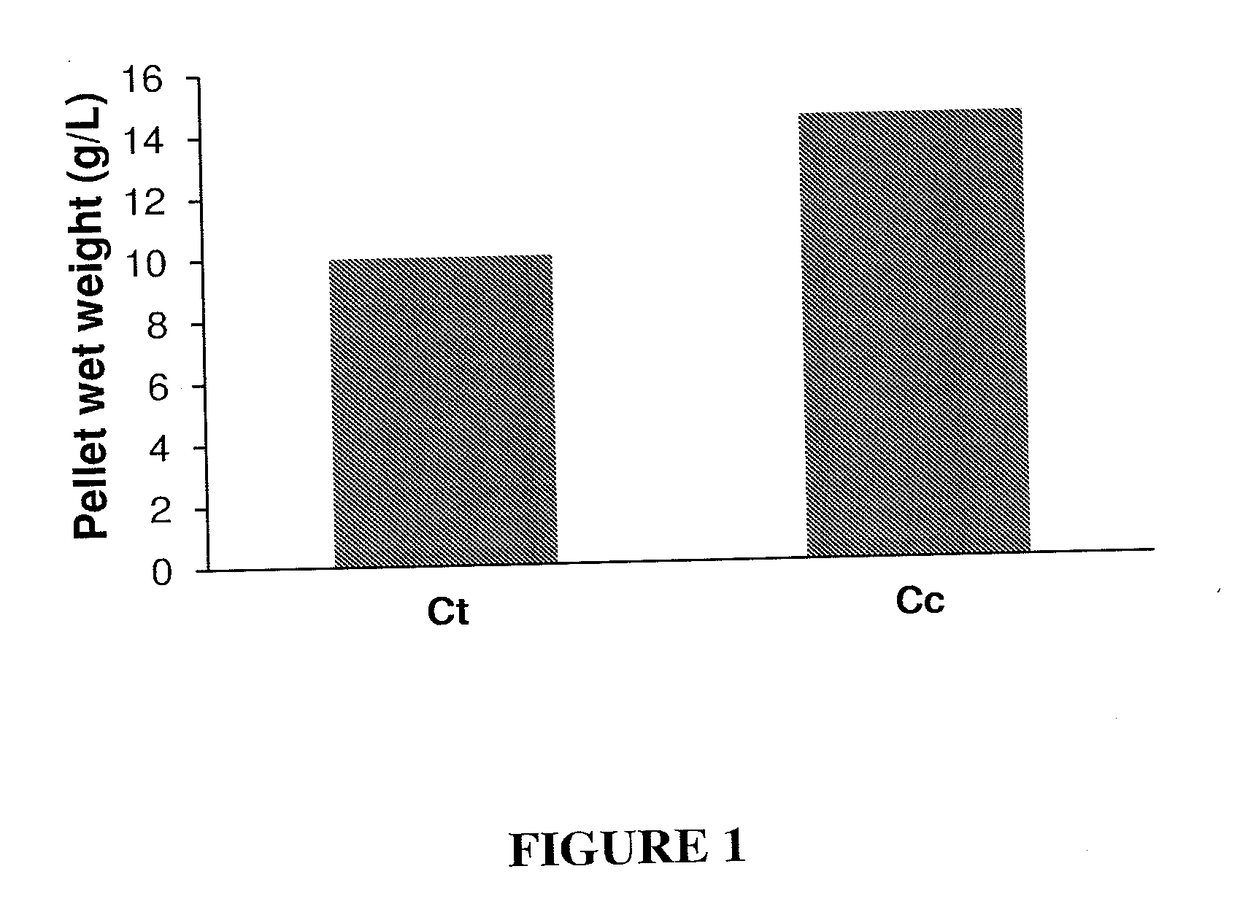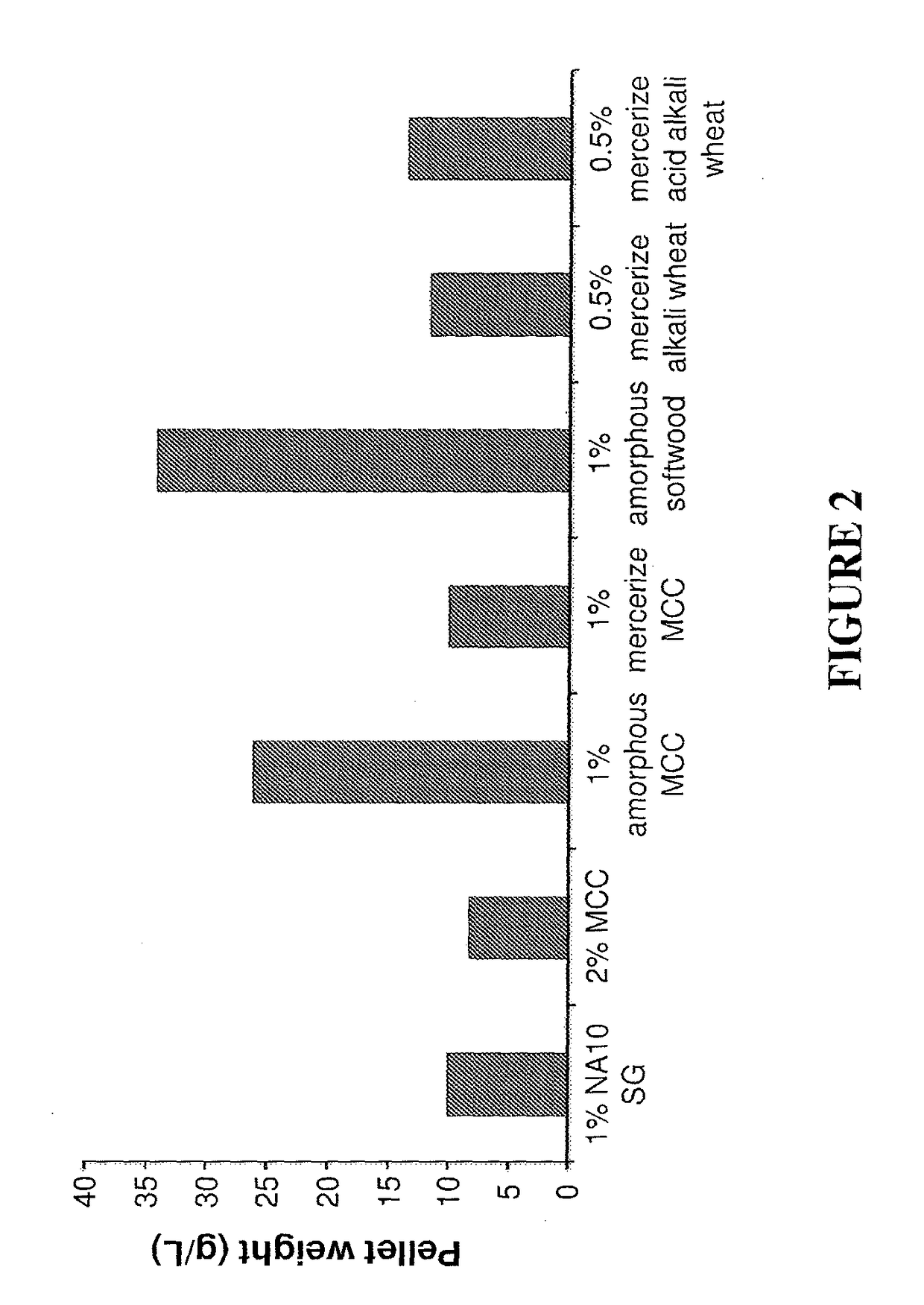Highly potent cellulolytic enzyme preparations and processes for producing same
a cellulolytic enzyme and high-potency technology, applied in the field of enzyme preparations, can solve the problems of high cost, many efforts have been given to reduce the cost of treatment, and methods have several limitations, so as to improve the activity of preparation, enhance cellulose degradation, and increase the concentration of soluble sugars
- Summary
- Abstract
- Description
- Claims
- Application Information
AI Technical Summary
Benefits of technology
Problems solved by technology
Method used
Image
Examples
example 1
Production of Cell-Associated Cellulosomal Pellet by Clostridium thermocellum and Clostridium clariflavum
[0167]Clostridium thermocellum (Ct) DSM 1313 and Clostridium clariflavum (Cc), both are anaerobic cellulosome-producing bacteria, were first grown in a serum bottle containing 100 ml of 0.8% cellobiose, 0.5 g / L MgCl2, 1.3 g / L (NH4)2SO4, 0.5 g / L KH2PO4, 0.5 g / L K2HPO4, 10.5 g / l MOPS, 5 g / L yeast extract and 2 mg / L resazurin. The pH was adjusted to 7.2 with 10 M NaOH. Prior to the addition of the bacteria, the medium was boiled and 1.3 g / L cysteine-HCl was added and purged with nitrogen. Medium was autoclaved for 15 minutes at 121° C. The fermentation was done at 60° C., 16-24 h until the OD 595 reached 0.8 to 1.3. The obtained starter medium was then inoculated to a bioreactor containing 1.2 L comprising of: 1% mercerized MCC and containing 0.5 g / L MgCl2, 1.3 g / L (NH4)2SO4, 1.33 g / L KH2PO4, 4.39 g / L K2HPO4, 5 g / L yeast extract, 2 mg / L resazurin, 0.4% antifoam, 1.25 mg / L FeSO4, 73...
example 2
Production of Cell-Associated Cellulosomal Pellet on Different Biomass Types
[0169]C. thermocellum DSM 1313 was first grown in a serum bottle containing 100 ml of 0.8% cellobiose, 0.5 g / L MgCl2, 1.3 g / L (NH4)2SO4, 0.5 g / L KH2PO4, 0.5 K2HPO4, 10.5 g / l MOPS, 5 g / L yeast extract and 2 mg / L resazurin. The pH was adjusted to 7.2 with 10 M NaOH. Prior to the addition of the bacteria, the medium was boiled and 1.3 g / L cysteine-HCl was added and purged with nitrogen. The medium was autoclaved for 15 minutes at 121° C. The fermentation was done at 60° C. for 16 h to 24 h until the OD 595 reached 0.8 to 1.3. The obtained starter was used to inoculate 1.2 L media containing one of the following biomass types: 1% untreated switchgrass (“1% NA10 SG”), 2% untreated microcrystalline cellulose (“2% MCC”), 1% MCC, amorphous pretreatment (“1% amorphous MCC”), 1% MCC, mercerize pretreatment (“1% mercerize MCC”), 1% softwood, amorphous pretreatment (“1% amorphous softwood”), 0.5% wheat straw, mercerize ...
example 3
Cellulose Hydrolysis by Cell-Associated Cellulosomal Pellet Produced Using Different Biomass
[0171]C. thermocellum was grown as described above on 0.8% cellobiose, 1% MCC or 0.5% mercerize and alkali pretreated wheat straw. A 1 L sample from each culture was centrifuged and the resulting pellets were weighted. The pellet weight was 4 g / l for 0.8% cellobiose containing media, 8.2 g / l for 1% MCC and 9.7 g / l for 0.5% alkali mercerized wheat straw.
[0172]The resulting pellets were tested for cellulolytic activity as described above. FIG. 3 shows hydrolysis of 10% MCC after 20 hours at 70° C. with cell-associated cellulosomal pellet produced using the different biomass. The results are expressed as the total amount (mmol) of soluble reducing sugars measured at the end of the assay.
[0173]The amount of soluble sugars was determined using DNS method (G. L. Miller, Anal. Biochem. 1959, 31, 426). As can be seen in the figure, higher cellulolytic activity was observed when cells were grown on pr...
PUM
| Property | Measurement | Unit |
|---|---|---|
| temperature | aaaaa | aaaaa |
| temperatures | aaaaa | aaaaa |
| temperatures | aaaaa | aaaaa |
Abstract
Description
Claims
Application Information
 Login to View More
Login to View More - R&D
- Intellectual Property
- Life Sciences
- Materials
- Tech Scout
- Unparalleled Data Quality
- Higher Quality Content
- 60% Fewer Hallucinations
Browse by: Latest US Patents, China's latest patents, Technical Efficacy Thesaurus, Application Domain, Technology Topic, Popular Technical Reports.
© 2025 PatSnap. All rights reserved.Legal|Privacy policy|Modern Slavery Act Transparency Statement|Sitemap|About US| Contact US: help@patsnap.com



